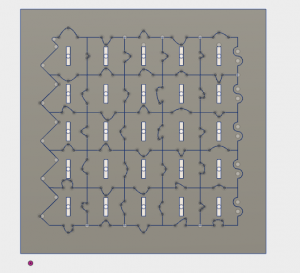Team Members: Phil Baker, Rory Hubbard, Nalini Jain

Description:
A transparent puzzle with LED’s which light up as the puzzle is assembled by completing a circuit. The puzzle has two layers: a bottom with a broken circuit and unique puzzle pieces with LEDs which cover the gaps, and complete the circuit. As the kids complete the puzzle, and hence the circuit the LED’s will light up accordingly.
y will see that a circuit must be in a close loop to work.
Target Age Group: 8-12
Learning Goals:
The primary learning goals for the children are the basics of circuitry and geometry. Having the LEDs light up only after the circuit is complete shows kids how there must be no breaks for current to flow. They will also notice that for parallel circuits, there are multiple loops that can be completed independently. Assembling the different puzzle pieces with respect to the board and other pieces give kids an understanding of basic geometry.
Operation Information:
The puzzle is composed of two layers: a bottom layer and top layer. The bottom layer has 5 rows of conductive tape on it with 5 breaks in the tape evenly spread out. The top layer consists of the actual pieces to the puzzle. Each puzzle piece has an LED on the top and conductive tape on the bottom side of it which, when placed in its correct position completes the break in the tape on the bottom layer. When a full row of pieces is aligned in their correct position, the circuit is close and all the LED’s in that row light up. When the puzzle is fully completed, all the pieces in the puzzle are lit up. The LED’s are powered by an external power supply. The power is transferred through alligator clips which clip onto two flanges of conductive tape that extend a little outside the boundary of the puzzle.
How did you make it?
Materials Used:
- Two sheets of acrylic – 4 dollars each
- 25 LED’s – 50 cents each
- Conductive Tape – 5 dollars for whole roll
Construction Process:
- CAD the puzzle in AutoDesk fusion 360
- Laser cut the puzzle from acrylic sheets
- Place the conductive tape on sheets/pieces of acrylic
- Solder LED’s onto puzzle pieces
Extensions:
Integration of Arduino will allow for self-selection of the colour for each LED. This would be for a slightly older age group (9-15) as kids would have to enter in their colour choices by using programming.
